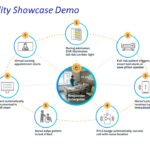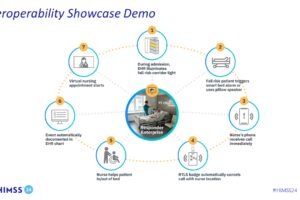The following is a guest article by Dale Quayle, CEO at RF Code
The data center infrastructure is constantly evolving. Over the last 12 months, companies have turned more frequently to cloud deployment for its presumed benefits. However, as this trend develops, many companies are recognizing the limitations of the cloud-only model and repatriating infrastructure tied to critical data in a housed facility. On-premises IT infrastructure is not going away anytime soon, and enterprise IT leaders have discovered that their on-premises infrastructure is necessary for specific uses.
On-premise and cloud computing offer valuable benefits when combined, particularly in highly regulated industries such as healthcare. Security is paramount when dealing with sensitive patient healthcare information. By utilizing enterprise or colocation data centers that maintain high levels of physical security measures (such as biometric access control) and environmental monitoring controls, organizations can ensure their most mission-critical data (financial, HIPAA records, etc.) is protected.
The use of public cloud services has unexpected financial downsides for businesses, too. When the volume of data compute spikes, the cloud costs balloon. Furthermore, by storing hardware within an external data center, organizations can guarantee reliable access to their systems. Micro data centers or colocation providers also maintain the edge infrastructure, including server security, cooling, power supply, and materials.
When combined, on-prem and cloud computing offers a truly unique set of benefits for highly regulated industries such as healthcare, including heightened security and reliability, scalability, predictable costs, improved flexibility, and agility.
- Cost Savings: Cloud is expensive. Some companies have reported that their cloud spend is, on average, 50% of their total cost of revenue (COR). A report from A16Z shows ‘that across 50 of the top public software companies currently utilizing cloud infrastructure, an estimated $100B of market value is being lost due to cloud impact on margins — relative to running the infrastructure themselves.’ By keeping your own servers and equipment either on-prem or at a colocation facility, you are utilizing the resources you already have, while protecting your most important data.
- Agility: By having a mix of on-premise resources as well as external storage/computing capabilities, companies are able to respond quickly to market changes or technological advances without being tied down by legacy infrastructure that may be expensive or difficult to upgrade. Ultimately, by taking advantage of a hybrid model, businesses are able to maximize efficiency while minimizing costs for maximum profitability.
- Security: For highly regulated industries, emphasis on managing and securing the IT physical assets cannot be overshadowed. Keeping the most important data out of the cloud allows organizations to ensure their data remains secure from unauthorized access.
All that said, healthcare organizations need to be sure that their on-prem or colocated servers (and the highly sensitive data on them) are protected like Fort Knox — which is the main goal of this hybrid approach. The sensitive nature of healthcare requires that organizations adhere to stricter security features in a data center as well as utilize the most advanced technology available. Hosting data on servers isn’t enough — those servers need to be monitored.
Smart networked sensors can monitor the temperature in your IT closet, saving your equipment from overheating and going down. Additionally, when using networked sensors, you receive real-time, deep intelligence that makes it easier to prevent, thwart, or remediate costly IT situations. It’s important to utilize sensor technology that doesn’t just “beep” at you when an anomaly is detected (i.e. the temperature of the server room is too high), however, but gives you more information about what the anomaly IS that created the alert. Don’t be fooled by sensors that just monitor the few inches in front of it. That doesn’t give you the whole picture about the status of the room or equipment. Advanced sensors that use broad thermal imaging so you can see down to the pixel level the temperature variants around the whole room, who walks in or out, doors left open, etc. are critical for protecting sensitive data and staying compliant.
A combination of both cloud and readily accessible on-premises/colocated infrastructure can provide an optimal blend of security, performance, data control, reliability, energy savings, and scalability. Keeping your highly critical and sensitive data securely in your own premises or a nearby colocation environment is what keeps you and your patients secure while still having access to the immense storage capacity benefits offered by the cloud. For ultimate protection for mission-critical applications in the healthcare sector – keep your most sensitive data on the ground!
 About Dale Quayle
About Dale Quayle
Dale Quayle is CEO of RF Code where he is responsible for the overall vision and strategy of the company as well as overseeing the launch of new products and the company’s entrance into new markets. Previously, he was CEO of Digital Fuel SV LLC, Interset Inc., as well as Intergrien Corp. He has a Bachelor of Science in Business and Economics from Illinois State University. Connect with him on LinkedIn.













